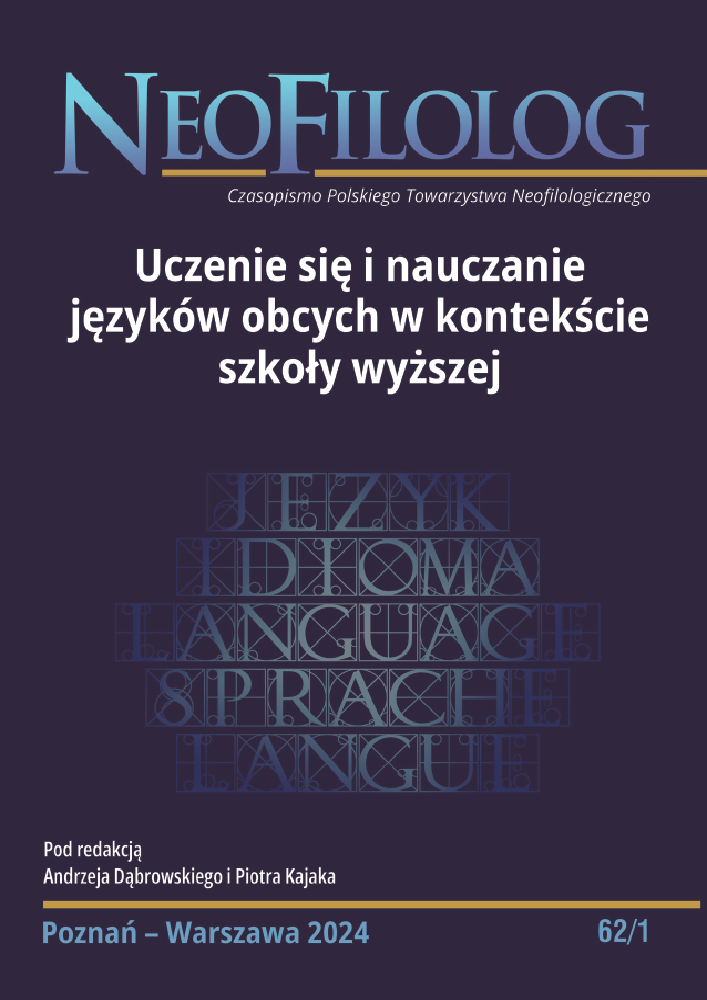Abstrakt
In the last decade, there has been a marked increase in interest in the use of mobile technologies in education, especially in language teaching. In the context of Mobile Assisted Language Learning (MALL), mobile applications offer unique features such as personalization, interactivity, and access to online resources, promoting individual language learning processes and supporting traditional teaching methods. This article focuses on the analysis of the effectiveness of the Duolingo application in teaching Russian at the University of Warsaw. The study was conducted in the summer semester of 2021/2022 with a group of 78 students. The results confirmed the positive impact of Duolingo on student engagement and the efficiency of material assimilation, while emphasizing the need for technical and educational support for the full use of the application. Study participants were keen on using Duolingo, particularly appreciating the reading lessons, although exercises aimed at developing speaking and writing skills were perceived as less effective. The conclusions of the study indicate the need for further research on the application of Duolingo in foreign language teaching and the analysis of its materials in the context of glottodidactics.
Bibliografia
Aleksandrowska O., Stanulewicz D. (2020), Internetowa platforma do nauki języków Duolingo – opinie użytkowników. „Neofilolog”, nr 55/1, s. 125–144. DOI: https://doi.org/10.14746/n.2020.55.1.8
Borawska-Kalbarczyk K. (2021), Proces kształcenia w cyfrowej rzeczywistości – wybrane kierunki zmian. Białystok: Wydawnictwo Uniwersytetu w Białymstoku. DOI: https://doi.org/10.15290/ewpspz.2021.07
Hussein B., Kopciewicz, L. (2018), Technologie własne czy szkolne? Podział cyfrowy i jego skutki w kontekście nauczania i uczenia się wzbogaconego technologicznie. „Forum Oświatowe”, nr 30(2), s. 199–218.
Burston J. (2014), The Reality of MALL: Still on the Fringes. „CALICO Journal”, nr 31(1), s. 103–125. DOI: https://doi.org/10.11139/cj.31.1.103-125
Gębal P. (2019), Dydaktyka języków obcych. Wprowadzenie. Warszawa: Wydawnictwo Naukowe PWN.
Herring M. C., Meacham S., Mourlam, D. (2016), TPACK development in higher education, (w:) Koehler M. J., P. Mishra (red.) Handbook of Technological Pedagogical Content Knowledge (TPACK) for Educators: Second Edition. Nowy Jork: Routledge, s. 207–224. DOI: https://doi.org/10.4324/9781315771328
Jakubiak O. (2015), PBL jako metoda aktywizacji językowej studentów studiów filologicznych, (w:) Mytnik-Ejsmont, J., Glac, W., Majcher, I. (red.), Echa ideatorium: z doświadczenia nauczycieli akademickich, uczestników 2. Konferencji Dydaktyki Akademickiej „Ideatorium” na Wydziale Biologii Uniwersytetu Gdańskiego. Wydział Biologii Uniwersytetu Gdańskiego, s. 37–47.
Krajka J., Białek K. (2021), O stylach dydaktycznych w edukacji zdalnej w teorii i praktyce z przykładami scenariuszy wykorzystanych w programie Teaching English in Poland. „Języki Obce w Szkole”, nr 1, s. 5–15.
Koehler M. J., Mishra P. (red.) (2016), Handbook of Technological Pedagogical Content Knowledge (TPACK) for Educators. Routledge.
Kukulska-Hulme A., Traxler J. (red.) (2005), Mobile Learning: A Handbook for Educators and Trainers. Londyn: Taylor and Francis.
Kukulska-Hulme A., Traxler J. (2013), Design principles for mobile learning. (w:)Beetham, H., Sharpe, R. (red.), Rethinking Pedagogy for a Digital Age: Designing for 21st Century Learning (2nd ed.). Abingdon: Routledge, s. 244–257.
Lopez-Perez M.V., Perez-Lopez M.C., Rodriguez-Ariza, L. (2011), Blended learning in higher education: Students’ perceptions and their relation to outcomes. „Computers & Education”, nr 56(3), s. 818–826. DOI: https://doi.org/10.1016/j.compedu.2010.10.023
Parmaxi A., Demetriou, A. A. (2020), Augmented reality in language learning: A state of the art review of 2014–2019. „Journal of Computer Assisted Learning”, nr 36(6), s. 861–875. DOI: https://doi.org/10.1111/jcal.12486
Padzik D. (2021), Nauczyciel XXI wieku – role i wyzwania. „Języki Obce w Szkole”, nr 2, s. 71–76.
Radomyski K. (2022), Opinie użytkowników aplikacji Duolingo. Analiza komentarzy z Google Play Store. „Języki Obce w Szkole”, nr 3, s. 103–112.
Savvani S. (2019), State-of-the-Art Duolingo: Features and Applications, (w:) Auer M. E., Tsiatsos T. (red.), The Challenges of the Digital Transformation in Education: Proceedings of the 21st International Conference on Interactive Collaborative Learning (ICL 2018). Volume 2. Springer International Publishing, s. 139–147. DOI: https://doi.org/10.1007/978-3-030-11935-5_14
Sikorska J. (2023), Model SAMR w kreowaniu cyfrowego środowiska uczenia się języka obcego przez dzieci w wieku wczesnoszkolnym. „Edukacja Elementarna w Teorii i Praktyce”, nr 18(69), s. 43–54. DOI: https://doi.org/10.35765/eetp.2023.1869.04
Szałek M. (2004), Jak motywować uczniów do nauki języka obcego. Motywacja w teorii i praktyce. Poznań: Wagros.
Werbach, K., Hunter, D. (2012), For the Win: How game thinking can revolutionize your business. Wharton Digital Press.
Wilczyńska, W., Michońska-Stadnik A. (2010), Metodologia badań w glottodydaktyce. Wprowadzenie. Kraków: Avalon.
Vinogradova I.V. i in. (2022), Gejmifikaciâ kak metod obučeniâ: osobennosti i vozmožnosti, „Moskovskij èkonomičeskij žurnal”, nr 3, s. 702–708.
https://app.mondly.com/ [DW 15.09.2023]
https://azpbs.org/2021/11/teacher-app-recommendation-padlet/ [DW 15.09.2023]
https://blog.duolingo.com/goldilocks-and-the-cefr-levels-which-proficiency-level-is-just-right/ [DW 15.09.2023]
https://blog.duolingo.com/the-duolingo-cefr-checker-an-ai-tool-for-adapting-learning-content/ [DW 15.09.2023]
https://www.duolingo.com/approach/ [DW 20.12.2023]
https://duoplanet.com/duolingo-languages-list/ [DW 20.12.2023]
https://duoplanet.com/duolingo-russian-review/ [DW 20.12.2023]
https://edunews.pl/narzedzia-i-projekty/narzedzia-edukacyjne/4125-odpowiedz-filmem-czyli-flipgrid/ [DW 15.09.2023]
https://forum.duome.eu/ [DW 28.12.2023]
https://international.uni.wroc.pl/en/admission-full-degree-studies/english-language-requirements/ [DW 15.09.2023]
https://www.mondly.com/blog/introducing-first-augmented-reality-language-app-speech-recognition/ [DW 15.09.2023]
https://play.google.com/store/apps/details?id=com.duolingo&hl=pl&gl=US&pli=1/ [DW 28.12.2023]
https://www.techlearning.com/ [DW 15.09.2023]
Licencja
Prawa autorskie (c) 2024 Katarzyna Gajda

Utwór dostępny jest na licencji Creative Commons Uznanie autorstwa – Bez utworów zależnych 4.0 Międzynarodowe.
Przedstawiany utwór (artykuł) upubliczniany jest na podstawie umowy z autorem i na licencji Creative Commons Attribution-NoDerivatives 4.0 International (CC BY-ND 4.0).
Użytkownicy mają obowiązek podania wraz z rozpowszechnionym utworem, informacji o autorstwie, tytule, źródle (odnośniki do oryginalnego utworu, DOI) oraz samej licencji;
- bez tworzenia utworów zależnych,
- utwór musi być zachowany w oryginalnej postaci.
Uniwersytet im. Adama Mickiewicza w Poznaniu zachowuje prawo do czasopisma jako całości (układ, forma graficzna, tytuł, projekt okładki, logo itp.).

